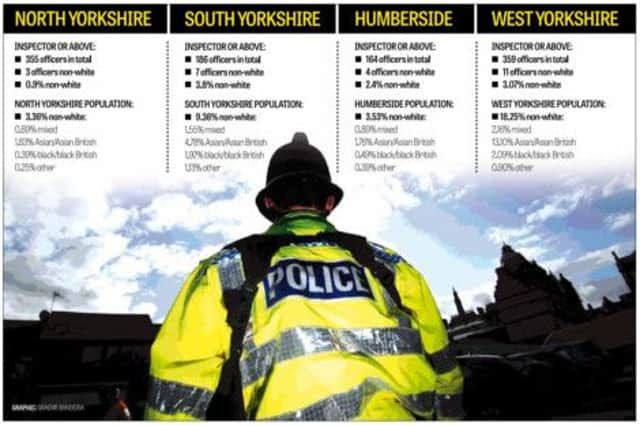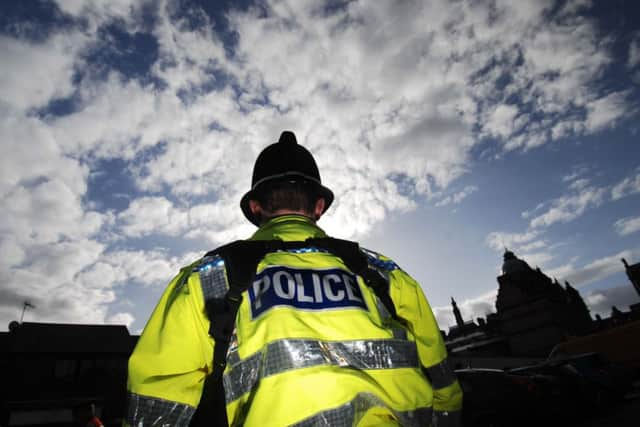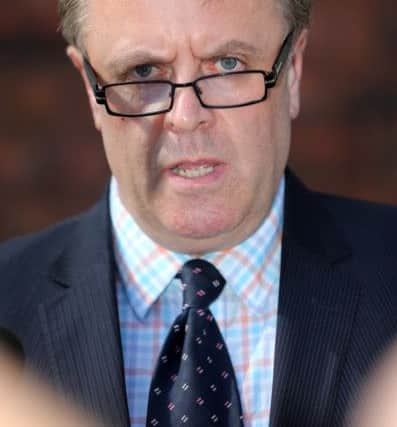Why the thin blue line is all too white in upper ranks of Yorkshire’s police


As Dewsbury-based Sergeant Anita Patel can testify, the task became harder from 2010 when Government funding cuts kicked in, meaning fewer new recruits joining the force and fewer promotions up the ranks.
The force’s failure to recruit BME officers in recent years now means barely three per cent of its officers of inspector-rank and above are of BME origin, with no non-white officers at all from chief superintendent and above.
Advertisement
Hide AdAdvertisement
Hide AdAnd despite improvements in recent years, and the presence, until this year, of the country’s first Asian officer to serve as Deputy Chief Constable, all but five per cent of the nearly 4,800 men and women donning West Yorkshire Police uniform are white.


Mrs Patel, an officer of 14 years experience, had a major role in the force’s branch of the Black Police Association, considered to be “influential and active” until its funding was merged with that of others representing minority groups.
She said: ”At West Yorkshire we have always been below the standard that was set [for the number of BME officers]. Because of the funding issue and austerity measures, people leaving aren’t being replaced. If you lose a BME officer or staff they won’t be replaced by another BME employee.
“Among the high-ranking officers you do get fewer BME officers. If you go further, to female BME, the highest ranking we have got is an inspector, and there is only one, and we are the fourth largest force in the country.”
Advertisement
Hide AdAdvertisement
Hide AdDespite the difficulties, Mrs Patel says West Yorkshire’s branch of the Black Police Association is able to raise issues of concern and has a good relationship with the force’s command team.


She said: “If we have any issues we can raise them. We do have a minority of BME staff who don’t feel they have been treated fairly but you have that at any force.
“I work in Dewsbury, which is quite diverse. The staff we have got, we have got one BME officer on my team who is a PC and that is it, though we do have other BME officers across the teams at Dewsbury.
“We have got a PCSO covering Savile Town and she has made great inroads in that community and she is not a BME officer.
Advertisement
Hide AdAdvertisement
Hide Ad“You don’t need to be BME to have that impact but we do need more BME officers for those diverse areas where some people might not engage.”


Just 6,966 of the 131,258 police officers in England and Wales, or 5.2 per cent, according to figures from this year, are from ethnic minority backgrounds, compared to an estimated 13 per cent of the British population.
And a watchdog report in August raised fears that an overwhelmingly white police force will struggle to engage with communities as the number of minorities in the UK rises.
West Yorkshire Police, the region’s largest force, has just 11 non-white officers at inspector or above out of a total of nearly 360 posts, though more than five per cent of its total officer strength is of a BME background.
Advertisement
Hide AdAdvertisement
Hide AdIt has five non-white superintendents but no non-white officers among its chief inspectors, chief superintendents or senior command team. The force’s Director of Human Resources, Hilary Sykes, said it strives “to be representative of the communities we serve” and had achieved a gradual rise in the number of officers from a BME background.
But she said: “In recent years, financial constraints have limited the recruitment of new officers which, in turn, has had an impact on the opportunities to increase the number of appointments and the progression of people from a BME background.
“We are currently recruiting Special Constables who are a vital part of our workforce and would encourage applications from a wide range of communities.”
West Yorkshire’s failure to recruit BME officers may provide an explanation for the force’s perceived problems engaging with its ethnic minority communities.
Advertisement
Hide AdAdvertisement
Hide AdIts police and crime commissioner admitted in July that there is a perception ethnic minorities and young people are unfairly targeted in the county when ‘stop and search’ is carried out.
A recent report highlighted the fact that, amid a rise in the number of complaints from the public about the force, 31 per cent of complainants are from an ethnic minority background.
And earlier this year the Independent Police Complaints Commission said complaints about discrimination by officers at the force, as well as their counterparts in Greater Manchester and the West Midlands, were “poorly handled from beginning to end”.
According to Franstine Jones, president of the National Black Police Association, West Yorkshire’s problem shared by police forces across the country, with only one non-white officer ever having risen to chief constable.
Advertisement
Hide AdAdvertisement
Hide AdWest Yorkshire’s crime commissioner says there is “no doubt” more needs to be done to encourage ethnic minority applicants to apply for policing jobs.
But Mark Burns-Williamson has come under fire from a campaign group for failing to employ a single member of staff in his office who was not ‘white British’.
Ratna Lachman, director of JUST West Yorkshire, a body aiming to promote ‘racial justice, civil liberties and human rights’, said she was “disappointed but not surprised at the low recruitment, retention and promotion rate of BME police officers within West Yorkshire Police”.
She said: “We have supported a number of BME officers within the force who have been subjected to racism and discrimination over the years and they have had no choice but to leave because of a patent lack of leadership from the top to tackle the institutional racism. We have challenged the Police and Crime Commissioner Mark-Burns Williamson for failing to recruit even one BME employee in his office.
Advertisement
Hide AdAdvertisement
Hide Ad“The lack of diversity within West Yorkshire police ultimately has an impact on the service that ethnic minorities receive.”
A spokesman for Mr Burns-Williamson confirmed that all 26 employees in the office of the police and crime commissioner (OPCC) were white British. Twenty-one are female and five male.
He said “It is extremely important that police forces reflect wherever possible the communities they serve and it is a concern here in West Yorkshire as elsewhere in the country that this is not proportionate particularly across the highest ranks.
“West Yorkshire was the first police force to have an Asian police officer serving as a Deputy Chief Constable but there is no doubt that more needs to be done by West Yorkshire Police and indeed the OPCC to encourage people from all communities to apply for vacancies.”
Advertisement
Hide AdAdvertisement
Hide AdHe said the recruitment of part-time special constables was targeted in “under-represented communities”.
The Government’s controversial ‘direct entry’ scheme, where applicants from outside the police service can be parachuted in at superintendent level, is seen as one method of making its higher ranks more diverse.
North Yorkshire Police’s direct entry superintendent, who starts work on Monday, is one of ten taken on around the country. Four will be women and two from an ethnic minority background, a more representative mix than the current superintendent ranks.
A spokesman for the Association of Chief Police Officers said: “The police service is acutely aware of the importance of representation of BME officers and staff at all levels to help ensure the police service’s legitimacy and effectiveness.
Advertisement
Hide AdAdvertisement
Hide Ad“Policing is a long career ladder and placing a burden of expectation on people to advance to the most senior positions can be difficult, but many chief officers are investing huge time and effort in mentoring and encouraging BME colleagues to progress through the ranks.”
Police forces also hope to recruit more non-white workers through the ranks of part-time special constables.
Shadow Home Secretary Yvette Cooper said: “The police need to reflect the communities they work in. There are still far too few black and minority ethnic senior officers in Yorkshire. The government has shown no leadership on this issue and progress has stalled. There should be a requirement on police forces to have active recruitment policies to tackle discrimination and increase diversity.”
A spokeswoman for Humberside Police said it was becoming more diverse but that its financial situation “has impacted on our ability to recruit externally and slowed down our attempts to ensure we are reflective of the local population as an organisation”.
Advertisement
Hide AdAdvertisement
Hide AdSouth Yorkshire Police said 4.7 per cent of its officers were of BME origin, slightly behind the national average, though its definition of BME is those who do not identify themselves as white British, rather than simply non-white.
A spokeswoman said: “BME inspectors in uniform roles, are very well represented, but besides a single detective chief inspector and chief inspector, managerial proportions of BME officers are otherwise below the average.”
She said: “South Yorkshire Police are continuing to utilise a positive action plan to try and meet the representation targets, in line with legal guidelines.”
North Yorkshire Police said it was “very keen to support the progression of officers from the widest range of backgrounds and skills”. It said: “We are currently in the process of revisiting our talent management programme to see how this could be better achieved and how we can learn from best practice elsewhere.”